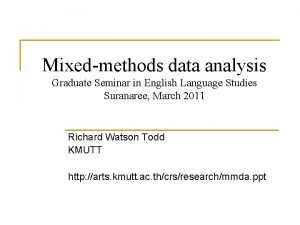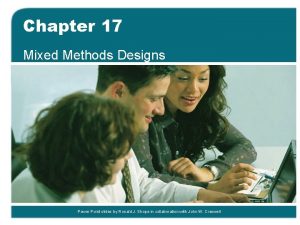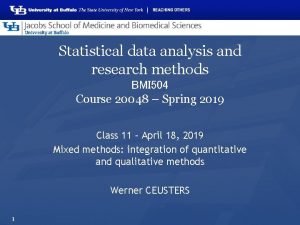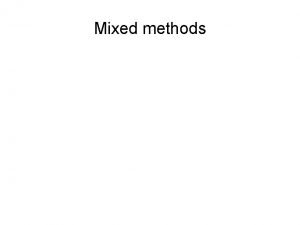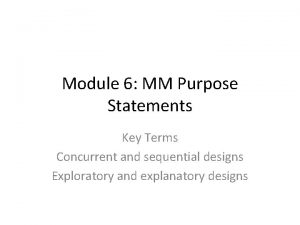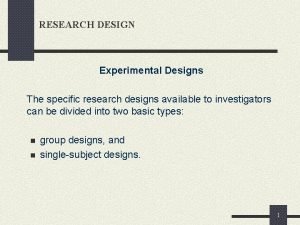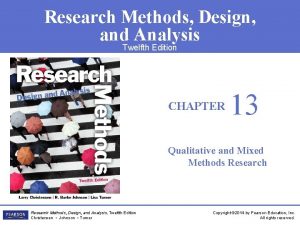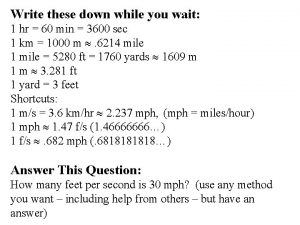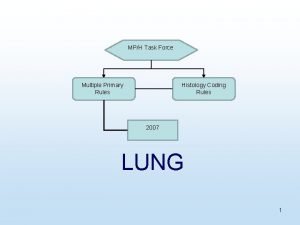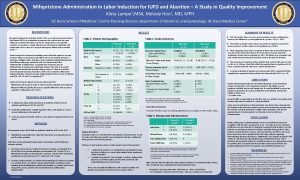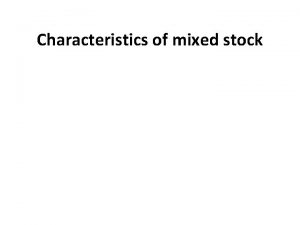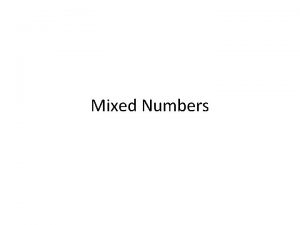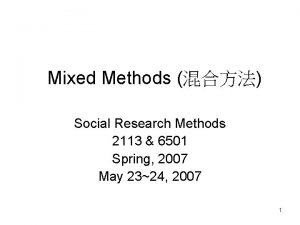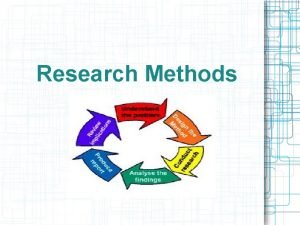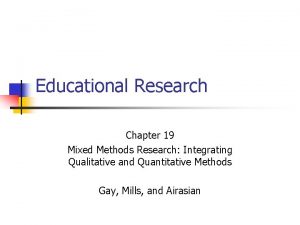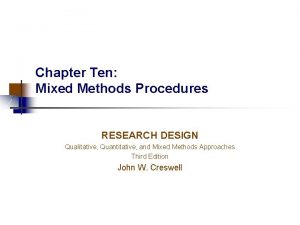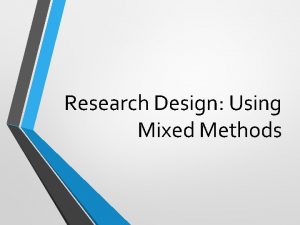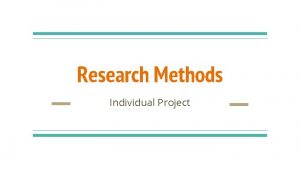Research Design Mixed Methods Elham Ahmadnezhad MD MPH























- Slides: 23

Research Design Mixed Methods Elham Ahmadnezhad MD. MPH. Ph. D Student of Epidemiology Tehran University of Medical Sciences Nov. 2009

Brief Description of Lecturer Dr Elham Ahmadnezhad is a researcher at the Department of Disaster and Emergency Management, National institute of health research, Tehran University of Medical Sciences. I’m a medical doctor and now I am studying Ph. D of Epidemiology. My interest is Disaster Epidemiology. My Email: elhamahmadnezhad@gmail. com Elham Ahmadnezhad. Mixed Methods 11/28/2020 2

Outlines Briefly History Why Mixed Methods? Type of Research designs Criteria for Choosing a Strategies Alternative Strategies and Visual Models Data Collection Procedures Data Analysis and Validation Procedures Report Presentation Structure Elham Ahmadnezhad. Mixed Methods 11/28/2020 3

Briefly History 1959: Concept of mixing different methods by Campbell & Fiske. (Psychologists) 1973: Combined the Qualitative & Quantitative data by S. D. Sieber. 1979: Converging or triangulating different Qualitative & Quantitative data sources by Jick. 1989 -2003: Expanded procedures for Mixed methods By Tashakkori & Teddli and then Creswell. Elham Ahmadnezhad. Mixed Methods 11/28/2020 4

Why Mixed Methods? Quantitative data can reveal generalizable information for a large group of people › These data often fail to provide specific answers, reasons, explanations or examples Qualitative research provides data about meaning and context regarding the people and environments of study › Findings are often not generalizable because of the small numbers & narrow range of participants Both methods have strengths and weaknesses › When used together, these methods can be complimentary Elham Ahmadnezhad. Mixed Methods 11/28/2020 5

Type of Research Design Quantitative, Qualitative and Mixed Methods Quantitative research Methods Qualitative research Methods Mixed Methods Research Methods • Experimental • Narratives • Sequential designs • Phenomenologies • Concurrent • Non- • Ethnographies Experimental • Grounded theory designs, such as • Case Studies • Transformative survey Elham Ahmadnezhad. Mixed Methods 11/28/2020 6

Criteria for Choosing a Strategies Four decisions go into selecting a mixed methods strategy Implement ation No Sequence Concurrent Priority Equal Integration At data collection Sequential. Qualitative first Qualitative At data analysis At data interpretation Sequential. Qualitative first Quantitative With some combination Elham Ahmadnezhad. Mixed Methods 11/28/2020 Theoretical Perspective Explicit Implicit 7

Criteria for Choosing a Strategies What is implementation sequence of the quantitative and qualitative data collection in the proposed study? What priority will be given to the quantitative and qualitative data collection and analysis? At what stage in the research project will the quantitative and qualitative data and finding be integrated? Will an overall theoretical perspective (e. g. , gender, race/ ethnicity, lifestyle, class) be used in the study? Elham Ahmadnezhad. Mixed Methods 11/28/2020 8

Alternative Strategies and Visual Models Sequential Explanatory Design qual QUAN Data Collection QUAN Data Analysis Qual Data Collection Qual Data Analysis Interpretation of Entre analysis Elham Ahmadnezhad. Mixed Methods 11/28/2020 9

Alternative Strategies and Visual Models Sequential Exploratory Design QUAL quan QUAL Data Collection QUAL Data Analysis Quan Data Collection Quan Data Analysis Interpretation of Entre Analysis Elham Ahmadnezhad. Mixed Methods 11/28/2020 10

Alternative Strategies and Visual Models Sequential Transformative Design QUAL quan Vision, Advocacy, Ideology, Framework QUAN qual Vision, Advocacy, Ideology, Framwork Elham Ahmadnezhad. Mixed Methods 11/28/2020 11

Alternative Strategies and Visual Models Concurrent Triangulation Strategy QUAN QUAL QUAN Data Collection QUAL Data Collection Qual Data Analysid Quan Data Analysis Data Results Compared Elham Ahmadnezhad. Mixed Methods 11/28/2020 12

Alternative Strategies and Visual Models Concurrent Nested Strategy Analysis of Findings Elham Ahmadnezhad. Mixed Methods 11/28/2020 13

Alternative Strategies and Visual Models Concurrent Transformative Strategy Elham Ahmadnezhad. Mixed Methods 11/28/2020 14

Data Collection Procedures Identify and be specific about the type of data. Some forms of data such as interviews and observations can be either quantitative or qualitative. Although reduction information to numbers is the approach used in quantitative research, it is also used in qual. Research. Recognize that quantitative data often involve random sampling, so that each individual has no equal probability of being selected and the sample can be generalized to the larger population. In qualitative data collection, purposeful sampling is used to that individuals are selected because they have experienced the central phenomenon. Elham Ahmadnezhad. Mixed Methods 11/28/2020 15

Data Collection Procedures Relate the procedures specifically to the visual model. For e. g, in a sequential explanatory model, the general procedures can be detailed even further. A discussion of this approach might include describing the use of survey data collection followed by both descriptive and infertial data analysis in the first phase. Then qualitative observations and coding and thematic analysis within an ethnographic design might be mentioned for the second phase. Elham Ahmadnezhad. Mixed Methods 11/28/2020 16

Data Analysis and Validation Procedures It’s related to the type of research strategy chosen for the procedures. Some of the more popular approaches: Data transformation: In the concurrent strategies involve creating codes and themes qualitatively, then counting the number of times they occur in the text data. This quantification of qualitative data enables a researcher to compare quantitative results with the qualitative data. For instance, in a factor analysis of data from a scale on an instrument, the researcher may create factors or themes that then can be compared with themes from the qualitative database. Elham Ahmadnezhad. Mixed Methods 11/28/2020 17

Data Analysis and Validation Procedures Explore outliers: In a sequential model, an analysis of quantitative data in the first phase can yield extreme or outlier cases. Follow-up qualitative interviews with these outlier cases can provide insight about why they diverged from the quantitative sample. Instrument development: In a sequential approach, obtain themes and specific statements from participants in an initial qualitative data collection. In the next phase, use these statements as specific items and themes for scales to create a survey instrument that is grounded in the views of the participants. A third, final phase might be to validate the instrument with large sample representative of a population. Examine multiple levels: in a concurrent nested model, conduct a survey at one level (e. g. with families) to gather quantitative results about a sample. At the same time, collect qualitative interviews (e. g. , with individuals) to explore the phenomenon with specific individuals in families. Elham Ahmadnezhad. Mixed Methods 11/28/2020 18

Data Analysis and Validation Procedures It is necessary the validation of both qualitative and quantitative phases of study. Each of methods has the specific ways, for the qualitative data, the strategies that will be used to check the accuracy of the findings need to be mentioned. Elham Ahmadnezhad. Mixed Methods 11/28/2020 19

Report Presentation Structure For a sequential study, mixed method researcher typically organize the report of procedures into quantitative data collection and qualitative data analysis followed by qualitative data and collection and analysis. Then, in the conclusions or interpretation phase of the study, the researcher comments on how the qualitative findings helped to elaborate on or extend the quantitative results. Alternatively, the qualitative data collection and analysis could come first followed by the quantitative data collection and analysis. In either structure, the writer typically will present the project as two distinct phases, with separate headings of each. Elham Ahmadnezhad. Mixed Methods 11/28/2020 20

Report Presentation Structure In concurrent study. The quantitative and qualitative data collection may be presented in separate section, but the analysis and interpretation combines the two forms of data to seek convergence among the results. The structure of this type of mixed methods study does not as clearly make a distinction between the quantitative and qualitative phases. Elham Ahmadnezhad. Mixed Methods 11/28/2020 21

Report Presentation Structure In a transformative study, the structure typically involves advancing the advocacy issue in the beginning of the study and then using either the sequential or concurrent structure as a means of organizing the content of the study. In the end of the study, a separate section may advance an agenda for change or reform that has developed as a result of the research. Elham Ahmadnezhad. Mixed Methods 11/28/2020 22

References Creswell, J. W. (2003). Research design. Sage publication. Tashakkori, A. , & Tedllie, C. (2003). Handbook of mixed methods in the social and behavioral sciences. Thousand Oaks, CA: Sage. Elham Ahmadnezhad. Mixed Methods 11/28/2020 23
 Mixed methods research examples
Mixed methods research examples Mixed methods research examples
Mixed methods research examples Mixed methods research ppt
Mixed methods research ppt Convergent design mixed methods
Convergent design mixed methods Convergent design mixed methods
Convergent design mixed methods Dr elham altaf
Dr elham altaf Vega pentest
Vega pentest Mohammad alomar
Mohammad alomar Pragmatisk tilgang
Pragmatisk tilgang Mixed methods program evaluation
Mixed methods program evaluation Research purpose statement examples
Research purpose statement examples Metode penelitian kombinasi (mixed methods)
Metode penelitian kombinasi (mixed methods) Research design methods
Research design methods Research methods design and analysis
Research methods design and analysis Types of research design exploratory descriptive causal
Types of research design exploratory descriptive causal Direct wax pattern
Direct wax pattern Wait 1 h
Wait 1 h How fast does light travel
How fast does light travel Mph rules
Mph rules Bachelor of public health monash
Bachelor of public health monash 186 000 miles/sec in mph
186 000 miles/sec in mph 451 kts to mph
451 kts to mph Stfm conference
Stfm conference Melody hou md mph
Melody hou md mph
